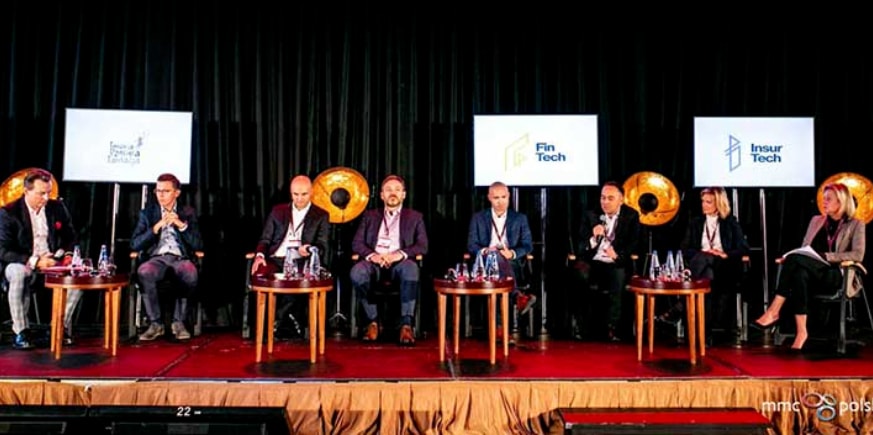
Nowadays, the FinTech industry flourishes and transforms along with the e-commerce and retail industries. COVID-19 has created an entirely new scenery of buying and selling products and services. We prefer to purchase products online, from the comfort of our homes. And what comes with every purchase? Exactly – payment. That’s why the FinTech industry is now immensely important and is a key factor in facilitating retail transformation. We had a great privilege to talk with industry experts during FinTech & Insurance Congress and want to share with you a glimpse of it.
When it comes to payments, there is one crucial buzzword that shapes the industry – safety. No matter if we use a credit card or other form of online payment, we want to be sure that our digital wallet is 100% safe. The speed matters too! Today, it takes less than 10 seconds to pay for the product purchased online.
And the fact is, e-commerce safety is to remain a key area of investment in this sector in 2020. As technology changes, sellers will need to provide solutions that will ensure and increase confidence and security in purchasing processes. Still, over 42% of Internet users believe that their data is misused online. We can expect to see many solutions that should deal with this problem.
But there’s much more going on in the modern FinTech industry. Time to find out what exactly!
The invisible payments and autonomous stores
This technology is relatively new, and COVID-19 has significantly sped up the pace of invisible payments develop. With invisible payments, the cash registers and the entire checking-out process become obsolete. Inour previous articles we mentioned self-checkouts, a solution that allows you to pay for your groceries and other products with no interaction with the human cashier. Invisible payments and autonomous shops along with them are the next stage.
The grab and go solution works similarly. Even today, customers can use their smartphones to scan and pre-order items and just leave the shop with them. They make payments seamlessly, with no lines and a waste of time. This is how Amazon GO shops operate. Amazon’s algorithms constantly monitor the store and detect when products are taken from or returned to the shelves. They keep track of them in a virtual cart. When a customer finishes their shopping, they can just leave the store. A receipt is issued, and money is taken from the user’s Amazon account.
This technology allows customers to enter the store, do shopping, and simply walk out of the store afterward, leaving their mobile device to process the payment automatically.
Biometric scanning
Soon, no one will need a card, smartphone, or a smartwatch to pay for their purchases. We can expect that, over time, it will be possible to fully eliminate these middlemen and authorize payments through biometric scanning. This means that, shortly, you won’t need money, a credit card, or your phone to go shopping. You will be able to pay with your finger, eye, face, voice, or even specific behavior.
And this revolution happens already! Consider Fingopay. It’s a UK-based startup that works on innovative paying methods. Their VeinID uses blood vessel biometrics to make payments. It does not require a physical carrier. All you need to do is register your biometric data and connect it with your Visa card.
Or check out PayEye, polish startup which is a natural r-evolution in payments because when paying with PayEye, you don’t need a wallet, payment card, watch or telephone, all you need is one look!
The growth of cashless payment solutions
Although this technology has been around for years, nowadays, it flourishes. People all around the globe willingly use cashless payments, and more and more governments are working on solutions that would eventually eliminate cash. Sweden is a great example. Half the nation’s retailers predict they will stop accepting bills before 2025 [1].
A similar situation is in Poland. According to the report “Cashless payments through the eyes of Poles 2019”, as many as 79% of Poles choose non-cash payments. Poles prefer card payments (66%), phone payments (7%), and finally, the use of internet banking (6%). Moreover, only 20% of Poles declare an attachment to traditional money, and 8% do not use ATMs at all [2].
Today, fewer and fewer people carry cash. We are already used to paying with “plastic money”. You can pay with a credit card virtually everywhere, even in small, local shops. But there are also numerous online cashless payment solutions, to name just PayPal, Stripe, Authorize.net, Google Checkout, and Amazon Payments. In many instances, you don’t even need an account on these platforms to pay for a product!
And then you have the virtual banks. It’s a new way to store and transfer your money worldwide. Your banking account is 100% online, and these companies don’t even have stationary branches. Every year, virtual banks thrive. For instance, Revolut, one of these virtual banking companies, is predicted to grow by about 36% by 2021. Revolut’s user base will then hit 16 million.
Payments via Internet of Things
Modern payment terminals will connect to almost any device via the IoT technology in the near future. Just think of the possibilities it creates! Imagine that your refrigerator will be able to order food automatically when it detects that the supply is low. Or think of cars connected through IoT to the payment system that will be able to pay parking fees and tolls without the need to interact with the driver.
Internet of Things, along with Big Data, will also be commonly utilized to enhance supply chains and warehouse management.
Smartphones as POS devices
Visa is one of the companies that work on turning everyday smartphones into merchant Point of Sale terminals, so called Soft POS. This solution, available through an app, enables face-to-face payments with QR codes or NFC payments. The remote payments for home deliveries via link-based payments are also possible.
Soft POS creates a multitude of fantastic possibilities:
- You can record and store credit transactions the same way you would do in a normal store.
- Merchants can use this app to create a catalog of available products and offer convenience in ordering
E-commerce payment automation
In the not too distant past, payment automation in e-commerce was just a dream. You made your order and received an email with the banking account number that you had to transfer money to. You had to remember about typing in your order number and delivery address. Today, things are a bit different (thankfully!).
Nowadays, payments are fully automatic. You can easily use the aforementioned cashless solutions in your e-commerce business to receive money and manage orders. No more worries like “has this user has already paid for their order?” There is always an instant access to that data.
We didn’t mention all of the possible applications and innovations within the FinTech industry. If this subject interests you, we advise you to read more about:
- Bluetooth beacons
- Global Digital Currency
- Social and voice commerce
- Guided buying
- VR and AR in retail
The future of online payment solutions
What can we expect in the near future? Above all, we can expect biometric technology and tokenization to thrive. The goal is always the same – to ensure that online payments are safe.
Tokenization adds an extra level of security to sensitive credit card data. This process is based on replacing credit card data with an algorithmically generated number called a token. Usually, tokenization is used to prevent credit card fraud. Even today, virtual banks offer similar solutions to name just the single-use debit cards. You can generate a virtual credit card that can be used for just one transaction. When it’s completed, that credit card data disappears and can’t be used again. It’s a marvellous way to protect your money!
To sum up, the COVID-19 crisis drives the FinTech/e-commerce revolution. We can expect to see more and more solutions designed to pay in a quick and convenient way and to protect our funds.







